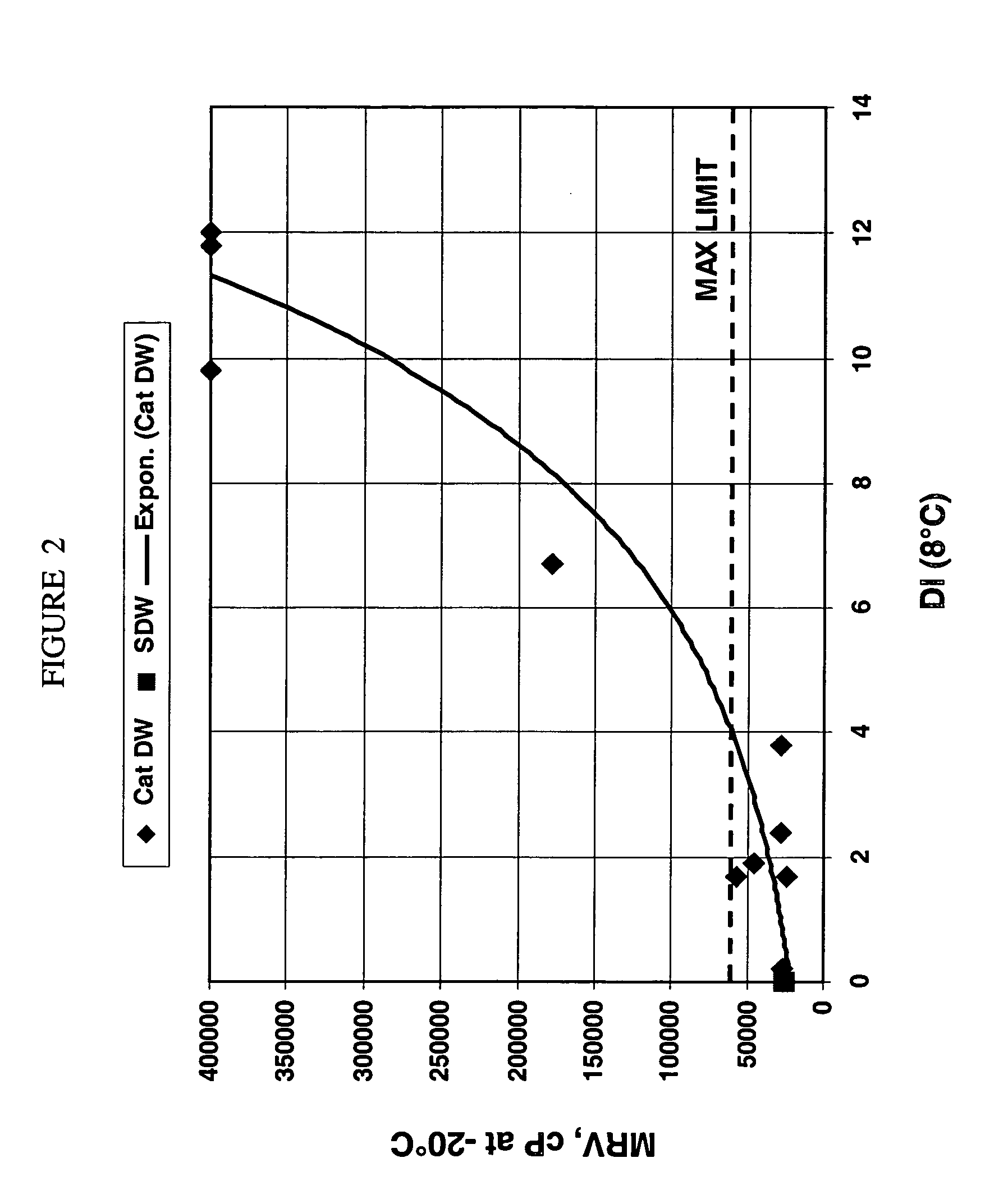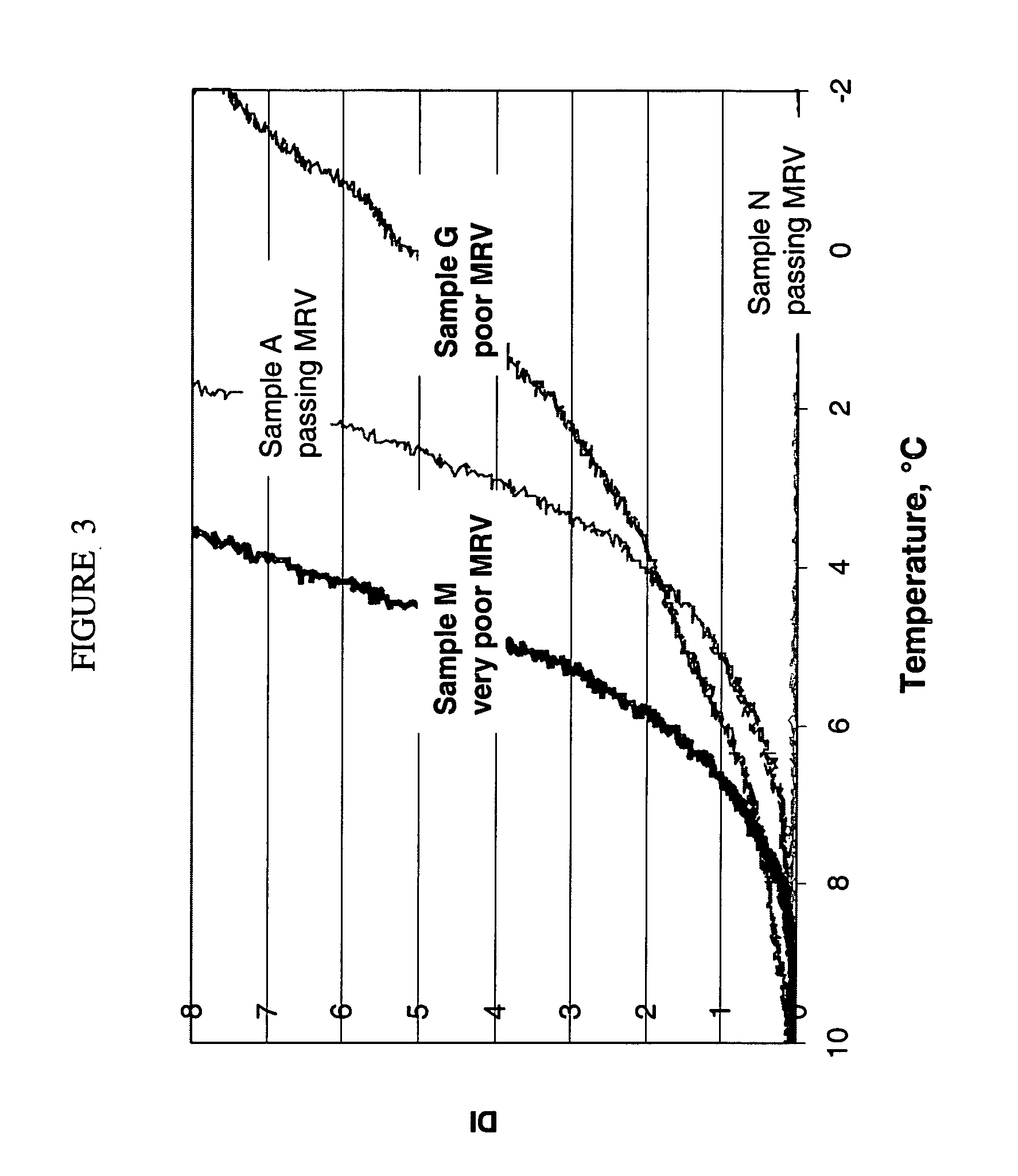Application of test for residual wax contamination in basestocks to correlate with the low temperature viscometric properties of fully formulated oils
- Summary
- Abstract
- Description
- Claims
- Application Information
AI Technical Summary
Problems solved by technology
Method used
Image
Examples
example 1
[0076] One of the basestock grades which is produced at most refineries is Bright Stock. This grade is produced either using a catalytic process (Cat DW) or a solvent dewaxing (SDW) process which uses solvents such as liquid propane or a mixture of methyl ethyl ketone (MEK) and toluene as the dewaxing solvent.
[0077] Depending on the processing conditions used and the mechanical state of the processing equipment, contamination by residual wax can occur. As noted earlier, the wax contamination may occur through rips or tears in the dewaxing filter cloth used in the SDW process, or by bypassing, channeling or poor catalyst selectivity in the Cat DW process.
[0078] Several samples of Bright Stock from various refinery sources and produced using the SDW or Cat DW process were evaluated in a study to determine the extent to which residual wax contamination was present, and to quantify the differences among the samples with respect to the mini-rotary viscometer (MRV) low temperature visco...
example 2
Control of MRV in 20W-50 Engine Oil using 2500 SUS Base
Stock Using Temperature Ramp
[0084] The samples of Example 1 were also tested using the same equipment as in Example 1 but a temperature ramp as in Embodiment 2 rather than a constant temperature soaking period. The specification target pour point for these base stocks is −6° C. After holding the sample at 100° C. for 1 hour, then shaking vigorously the sample was put in the test cell and subjected to this temperature program:
Starttemperature,End temp.,Rate,Time held at endStep° C.° C.° C. / minutetemperature, secondAambient20401800B20604010C6020400D20604010E60144010F14−20.25
The start temperature in step A refers to the temperature of the test cell. The sample temperature is near 100° C. just before being put into the test cell.
[0085] The temperature cycling sequence of steps B and C is not a mandatory step but is helpful to further reduce water content and dissolve wax in samples that turn hazy quickly. A separate stabiliz...
example 3
Control of MRV in 20W-50 Engine Oil using primarily 600 SUS Base Stock
[0089] It is required for product certification that the MRV viscosity and yield stress of engine oils be less than specified values. One such formulation contains 67 wt % of a 600 SUS (nominally 600 Saybolt Universal Seconds at 100° F.) conventional base stock. The target pour point for these base stocks is −6° C. Formulated oils were blended with the same performance additive components, except that different 600 SUS samples were used. Those samples had the same pour point. However, formulated oil MRV yield stress and viscosity differed. The samples were tested using the same equipment as was used in Examples 1 and 2. The oils were heated and held at 100° C. for about one 15 hour, heating being carried out with the sample in a vial in an oven. Following heating and agitation, the samples were placed in test cells. The table below shows the good correlation of DI to MRV when a constant temperature of −4° C. is ...
PUM
 Login to View More
Login to View More Abstract
Description
Claims
Application Information
 Login to View More
Login to View More - R&D
- Intellectual Property
- Life Sciences
- Materials
- Tech Scout
- Unparalleled Data Quality
- Higher Quality Content
- 60% Fewer Hallucinations
Browse by: Latest US Patents, China's latest patents, Technical Efficacy Thesaurus, Application Domain, Technology Topic, Popular Technical Reports.
© 2025 PatSnap. All rights reserved.Legal|Privacy policy|Modern Slavery Act Transparency Statement|Sitemap|About US| Contact US: help@patsnap.com



